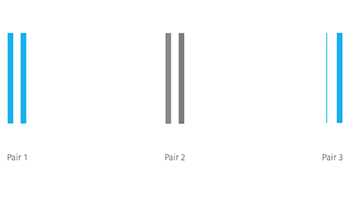
Whether two stimuli appear to be of different colors depends on a host of factors, ranging from the observer, via viewing conditions to content and context. Previously, studies have explored just noticeable difference thresholds for uniform colors viewed with or without spatial separation, for complex images and for fine features like lines in architectural drawings. An important case that has not been characterized to date is that of continuous color transitions, such as those obtained when selecting two colors and generating a sequence of intermediate colors between them. Such transitions are often part of natural scenes (e.g., sunsets, the sky, curved surfaces, soft shadows, etc.) and are also commonly used in visual design, including for backgrounds and various graphical elements. Where the just noticeable difference lies in this case will be explored here by way of a small-scale, pilot experiment, conducted in an uncontrolled, on-line way. Its results suggest a threshold in the region of 0.5 to 0.8 ΔE2000 for the few stimuli evaluated in the pilot experiment reported here and indicate a behavior that is in the region of viewing solid colors without a gap. A pilot verification with complex images also showed thresholds with a comparable range.

Imaging is enabled by the limitations of the human visual system, which is blind to certain physical differences. The trichromacy of human vision, e.g., allows for very different materials to be combined in a way that results in the same signals triggered by the eye’s cones. As a result a print can elicit the same response as a display, or a projection can yield colors like those in a painting. The limits of spatial acuity too allow for discrete patterns, e.g., those resulting from halftoning, to appear continuous. This paper turns its attention to the limits of color difference perception in stimuli with a very small subtense, such as thin lines or fine features of 3D objects. A first set of psychophysical data, obtained in an on-line visual experiment, indicates a dramatic relaxation of perceptibility thresholds when comparing very thin with thicker lines. The second half of the paper then presents printer imaging pipeline strategies that take advantage of these experimental findings to successfully render fine lines while taking advantage of the more limited sensitivity with which their specific colors are perceived.